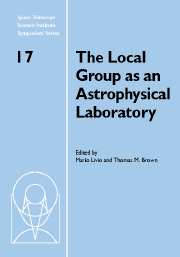 The Local Group as an Astrophysical Laboratory
The Local Group as an Astrophysical Laboratory Book contents
- Frontmatter
- Contents
- Participants
- Preface
- History of the Local Group
- Primordial nucleosynthesis
- Galactic structure
- The Large Magellanic Cloud: Structure and kinematics
- The Local Group as an astrophysical laboratory for massive star feedback
- Hot gas in the Local Group and low-redshift intergalactic medium
- Stages of satellite accretion
- The star formation history in the Andromeda halo
- Bulge populations in the Local Group
- The Local Group as a laboratory for the chemical evolution of galaxies
- Massive stars in the Local Group: Star formation and stellar evolution
- Massive Young Clusters in the Local Group
- Magellanic Cloud planetary nebulae as probes of stellar evolution and populations
- The old globular clusters: Or, life among the ruins
- Chemical evolution models of Local Group galaxies
Hot gas in the Local Group and low-redshift intergalactic medium
Published online by Cambridge University Press: 12 May 2010
- Frontmatter
- Contents
- Participants
- Preface
- History of the Local Group
- Primordial nucleosynthesis
- Galactic structure
- The Large Magellanic Cloud: Structure and kinematics
- The Local Group as an astrophysical laboratory for massive star feedback
- Hot gas in the Local Group and low-redshift intergalactic medium
- Stages of satellite accretion
- The star formation history in the Andromeda halo
- Bulge populations in the Local Group
- The Local Group as a laboratory for the chemical evolution of galaxies
- Massive stars in the Local Group: Star formation and stellar evolution
- Massive Young Clusters in the Local Group
- Magellanic Cloud planetary nebulae as probes of stellar evolution and populations
- The old globular clusters: Or, life among the ruins
- Chemical evolution models of Local Group galaxies
Summary
There is increasing observational evidence that hot, highly ionized interstellar and intergalactic gas plays a significant role in the evolution of galaxies in the local universe. The primary spectral diagnostics of the warm-hot interstellar/intergalactic medium are ultraviolet and X-ray absorption lines of O VI and O VII. In this paper, I summarize some of the recent highlights of spectroscopic studies of hot gas in the Local Group and low-redshift universe. These highlights include investigations of the baryonic content of low-z Ovi absorbers, evidence for a hot Galactic corona or Local Group medium, and the discovery of a highly ionized high velocity cloud system around the Milky Way.
Introduction
We live in a wonderful age of discovery and exploration of the universe. As we peer farther and farther back in time, it is becoming ever more important to make sure that we observe the local universe as well as possible. Observations of galactic systems and the intergalactic medium (IGM) in the low-redshift universe are required to study the universe as it has evolved over the last ∼5 billion years. They are essential for the interpretation of higher redshift systems, and they form a framework for studies of such key topics as galactic evolution, “missing mass,” and the distribution of dark matter. Studies of hot gas and its relationship to galaxies are shedding new light on these and other astronomical topics of interest today. In this review, I summarize some basic information about the elemental species and types of observations that can be used to study hot gas.
- Type
- Chapter
- Information
- The Local Group as an Astrophysical LaboratoryProceedings of the Space Telescope Science Institute Symposium, held in Baltimore, Maryland May 5–8, 2003, pp. 86 - 99Publisher: Cambridge University PressPrint publication year: 2006
- 2
- Cited by


